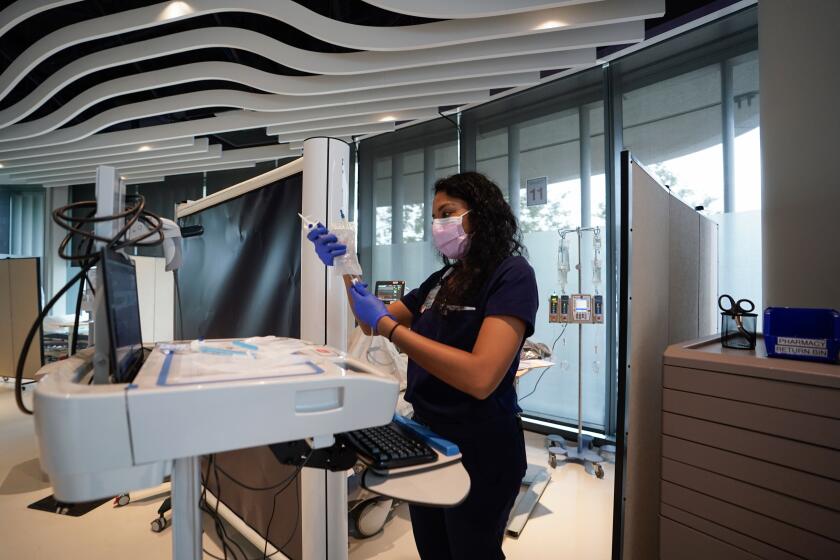Scripps Research might trim faculty due to money problems
The Scripps Research Institute in La Jolla might trim its faculty due to deepening money problems at the center, which is known worldwide for its studies of cancer, dementia, addiction and HIV-AIDS.
The institute will finish the fiscal year on September 30 with a $20 million operating deficit, which is $3.4 million higher than projected, according to Fitch Ratings, a major credit rating company.
This is the fifth consecutive year of deficit spending at Scripps Research, which has been struggling to raise federal research money. The non-profit institute also is suffering from the expiration of a research contract with a pharmaceutical company that was bringing in $20 million a year, Fitch said in a statement this week.
“On the expense side, there may be a gradual reduction of faculty in California, by attrition and retirement,” the agency said. The institute has 190 principal scientists.
Fitch announced that the financial problems, and leadership turnover, led it to downgrade $40 million in Scripps Research bonds. The rating fell from AA- to A+, a change announced on Wednesday. The money will be repaid with a $146.9 million bond that the institute will float this summer for a variety of projects.
Fitch labeled the institute’s credit status as stable, partly because it has a decent endowment. The agency also praised Scripps Research’s decision last fall to hire two highly-respected scientists -- Steve Kay and Peter Schultz -- to run the institute.
Kay, who is president, and Schultz, who is chief executive, say they’ll restore the institute’s financial health by having scientists focus on rapidly turning discoveries into new drugs and therapies, a field called translational medicine. Such discoveries can be worth millions in royalties and licensing fees.
“If this strategy works, there could be a lot of upside to it,” Fitch analyst Emily Wongsaid on Friday.
Schultz told the Union-Tribune Friday, “We are quite optimistic regarding both the financial stability of TSRI and its long term growth. This optimism stems from a combination of operational efficiencies, an increased focus on philanthropy, and several impending royalty streams.
”Moreover, we are developing a new self-sustaining model for nonprofit research that not only continues the TSRI tradition of outstanding biomedical research, but also effectively couples new research discoveries to translational research capabilities that will both accelerate their benefit to the public, as well as provide additional funds for future research.”
The financial problems at Scripps Research came to light in 2014 when it was revealed that former President Michael Marletta was quietly discussing a sale or merger of the institute to the University of Southern California.
Institute faculty were outraged that the talks were occurring without their input. Many researchers also didn’t want to become part of USC because it doesn’t enjoy the level of prestige that Scripps Research has built in the life sciences.
Scripps Research has helped to develop such well-known drugs as Humira, which is used to treat rheumatoid arthritis and other autoimmune diseases, Benlysta for lupus, and Surfaxin for infant respiratory distress syndrome. The institute also has been helping lead the effort to develop a vaccine for HIV-AIDS.
The faculty pressured Marletta and his board to break off negotiations with USC. But that didn’t solve the institute’s financial problems, which included operating deficits of $1.7 million in 2012, $25.5 million in 2013, $14.3 million in 2014, and $13.8 million in 2015.
Scripps Research also has experienced a huge drop in funding from the National Institutes of Health, the largest government underwriter of biomedical research. Funding has fallen by more than $55.2 million since 2012.
The institute has blamed the drop on increased competition for NIH money. However, many institutions, including UC San Diego, fared reasonably well, or experienced smaller losses during that same period. And the NIH budget was recently increased.
Scripps Research also has had trouble raising private donations. The opposite has been true at the nearby Salk Institute for Biological Studies and the Sanford Burnham Prebys Medical Discovery Institute.
At times, Scripps Research has downplayed its problems -- or denied that they exist.
Last fall, prominent institute chemist Phil Baran criticized the media’s coverage of the upheaval.
“The press didn’t give the full picture,” Baran told the Union-Tribune. “The financial problems were overblown. Scripps is actually in a very good position at this point. We are not bleeding money. We don’t have turmoil.”
Other faculty say the problems and tension persists, and that some professors are leaving. They include Ulrich Mueller, directror of the Dorris Neuroscience Center. He’s going to Johns Hopkins University, the institute said on Friday.
Fitch Ratings is closely monitoring what happens. The agency said in a statement, “Scripps operations are currently dependent upon the receipt of federal grantand drug royalty revenue. Should either of these sources experience further declines that cannot be managed budgetarily, the rating and/or outlook may be negatively affected.”
Get Essential San Diego, weekday mornings
Get top headlines from the Union-Tribune in your inbox weekday mornings, including top news, local, sports, business, entertainment and opinion.
You may occasionally receive promotional content from the San Diego Union-Tribune.












